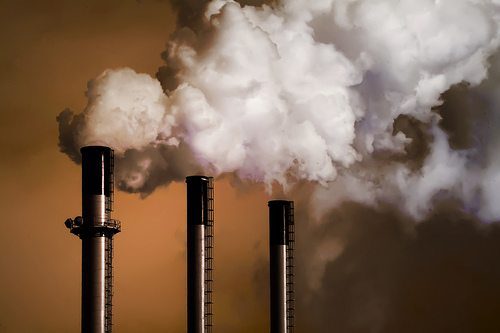The climate and clean energy policy of the Abbott government has descended further in pure farce with the release of critical details of the Direct Action scheme that reveals there will be no requirement on major energy polluters to limit greenhouse gas emissions.
Environment Minister Greg Hunt on Thursday released proposals for what are known as “safeguard” mechanisms of the emissions reduction fund, which will set a benchmark for polluters. If they move beyond the line, and increase emissions, they may face penalties.
The government says it has adopted “best practice guidelines”, but it does anything but. Electricity generators may have no baseline at all, in theory allowing a brown coal generator to increase emissions as much as it wanted.
Among the other 140 big polluters, the benchmark has been set at the highest level of pollution over the last five years. Some mines will be allowed to go beyond that if they can argue that “historical high point does not fully reflect expected business-as-usual emissions.”
The farcical proposals have been ridiculed by experts and analysts. Erwin Jackson, from the Climate Institute described it as a “climate policy you have when you don’t want to reduce emissions.”
The TCI described the emissions target as “phoney” and the safeguards as “feeble”. Even a lawyer, Grant Anderson, from the legal firm Allens, told Fairfax Media that it “won’t do much to control emissions.”
Hugh Grossman, from Reputex, an analyst firm owned by Standard & Poor’s, agreed the policy would do nothing to curb emissions growth.
“Given that emissions today are significantly lower than historical high levels, this will allow companies to increase their emissions from today’s levels, leading to considerable emissions growth through to 2020,” he said.
Indeed, Grossman said that the growth would likely overwhelm the pollution savings achieved by the ERF, which would pay big business for proposals to reduce emissions.
The Abbott government says the special treatment for the electricity sector is provided because of its “vital role” in the economy. Hunt’s office defended the exemption, telling Fairfax Media that the measures were “supported by industry.”
Of course they are. They’re probably writing the legislation.
Along with the Abbott government’s decision to scrap the carbon price and cripple the renewable energy target, and starve agencies such as ARENA of funds, threaten to close down the Clean Energy Finance Corporation, and abolish or diminish independent voices such as the Climate Change Authority and the Climate Commission, it has done nothing but serve the interests of fossil fuel generators.
The policy update came in the same week as the government rejected, out of hand, a proposal from the Clean Energy Council of a compromise deal on the RET. Abbott has drawn a line at 32,000GWh, a 40 per cent cut, and has refused to entertain the CEC’s offer of cutting the RET from 41,000GWh to 33,500GWh in the hope of gaining some investor certainty.
It also came as a new paper written by a former senior international negotiator noted that Australia risked throwing away any ability to influence the outcome of international climate talks – and of securing a favourable outcome for the Australian economy – because of its refusal to take the negotiations seriously. It said Australia’s influence had already been severely eroded since the Abbott government was elected.
Earlier this week, Hunt’s office released new data that confirmed that Australia’s emission reduction task – to meet its target of a 5 per cent reduction on 2000 levels by 2020 – had been trimmed to 236 million tonnes.
Just how this will be achieved with Direct Action and the ERF remains a mystery to the analysts, particularly in light of the safeguard mechanism proposals.
Reputex says emissions are forecast to rise 17 per cent above 2000 levels by 2020. And the ERF will be unlikely to purchase much more than half of its targeted abatement. It may be able to purchase as little as 60 million tonnes.
The TCI said described the government’s policy as an “economically reckless undermining of industries critical to Australia’s long-term prosperity”.
“By continuing to seek deep cuts to the Renewable Energy Target and proposing phony emissions limits that would allow pollution to rise, the government is signalling that they’re content for Australia to remain a clunker economy rather than modernising with the rest of the world.”
“The debate about climate policy shouldn’t be about what crumbs we can offer the clean energy industry till 2020. The spotlight should be on the deeper decarbonisation challenge, and the fact that our electricity system is held back by an aging, inefficient and polluting power generator fleet.”
But the TCI also questioned which of the mainstream parties showed it understood the economic transformation underway, let alone have a plan.
“Neither Party has a credible vision for the future without a strategy for decarbonising our energy and modernising our economy,” it said.
Opposition environment spokesman, Mark Butler, has meanwhile described the government’s policy as “nothing but a dressed up slush fund, wasting billions of taxpayers’ dollars while achieving no meaningful reduction in Australia’s pollution levels.
“It’s the most brazen capitulation to the big polluters since Tony Abbott reversed his election commitment to keep the Renewable Energy Target,” Butler said.
Even health advocacy group Doctors for the Environment Australia has been scathing in its assessment of the policy, arguing that its concessions to industry will continue causing heart and lung disease and shortening peoples lives.
“It requires great skill or oversight to prepare a document of 31 pages on climate change and the reduction of emissions without mentioning the word ‘health’ when the World Health Organization defines climate change as ‘the defining issue for public health during this century’,” said DEA spokesperson Dr David Shearman in a submission to the Climate Change Authority.
The group recommends Australia commit to a reduction target on 2020 levels of at least 40 per cent by 2025 and 95 per cent by 2050.











